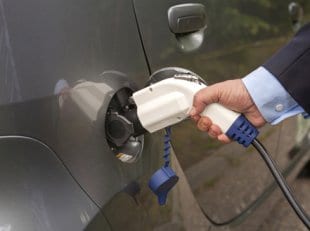Electric vehicle uptake in Australia has been painfully slow, a situation that a recent report estimated could cost the economy more than $350 million over the next 20 years, not to mention the environmental cost and risks associated with energy security.
That report, published by Energy Supply Association of Australia in July, blamed the “do nothing” approach of Australian governments for this, and suggested the introduction of some basic, low-cost incentives could boost EV uptake to almost one million in just 10 years.
But according to Bede Doherty, the e-mobility services manager at BMW-owned Alphabet Fleet, a lack of government subsidies is not what is hindering EV uptake in Australia (although policy support would be helpful). Neither, for that matter, is the perceived lack of public charging infrastructure. But the lack of education is.
A key part of this education should be on cost. As you can see in the graph below, which Doherty used in his presentation at RenewEconomy’s Disruption and the Energy Industry conference in Sydney on Wednesday, the cost of electricity to move a car is less than 2c/km, well below the rising cost of petrol.

The other key bit of information people should know about EVs, he says, is that “range anxiety” – that is, the fear of the EV battery running out of electric charge before reaching its destination – is only an issue with battery EVs (BEVs), or pure electric vehicles, that have no back-up fuel option. For the rest of the EV line-up – hyrbid EVs and plug-in hybrid EVs – this is “simply not an issue.”

Which brings us to another myth, says Doherty: that major EV uptake would require huge investment in public charging infrastructure in cities and suburbs.
But according to Doherty – whose big boss happens to own 50 per cent of EV infrastructure company ChargePoint – “only BEVs need it, sometimes. It’s nice, but it’s not essential.” That’s because more than 90 per cent of driving per car per day in Australia amounts to well under 90km, which is less than most current EV models outer range limit.
The other problem for Australia, Doherty told the conference, was a lack of EV model diversity – probably due to the lack of demand – despite the fact that every auto manufacturer in the world has an EV model, and will soon have more.
So what can we do to boost EV uptake? Get people to engage emotionally and intellectually, Doherty says, by highlighting the opportunities.
To illustrate those opportunities, Doherty provided another chart, showing that pure EVs were cheaper than their internal combustion engine (ICE) counterparts, regardless of the range they were driven each year (the average in Australia 14,000km per vehicle).

And while private buyers might still be put off by the initial purchase price, companies should be leading the way.
To help develop an understanding of the long-term savings, Doherty said, company fleets were vital to progress. “Private ownership follows company leadership,” he said.
Already, we are seeing companies in Australia turning to EVs to save money and cut emissions. Particularly large corporates dependent on fleets for their business – taxis being a prime example.

And while Doherty doesn’t see the need for governments to fund subsidies to drive electric vehicle uptake, they could certainly lead by example – like in Norway, which has achieved 100 per cent EV penetration in its government fleets.










